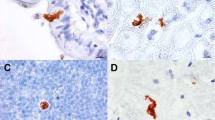Summary
This paper deals with the immuno-pathological characteristics of tick-borne encephalitis. With the appearance of neurological signs, there is a strong T cell reaction in the peripheral blood. The following seven days are characterized by the appearance of a specific cell-mediated reaction in the peripheral blood; in the cerebrospinal fluid, an increasing number of B cells and specific antibodies can be detected. After a week, the percent positivity of cell-mediated immune reactions is higher and there is a T cell dominance in the cerebrospinal fluid. Intact cellular immunity against specific antigen is required for the management of this disease. There are major differences in the results obtained from patients suffering from meningitis alone and those suffering from meningoencephalitis.
Zusammenfassung
Die immunpathologischen Charakteristika der Zecken-Enzephalitis wurden untersucht. Zum Zeitpunkt des Auftretens neurologischer Symptome findet sich im peripheren Blut eine ausgeprägte T-Zell-Reaktion. Die folgenden sieben Tage sind durch eine spezifische zellvermittelte Reaktion im peripheren Blut gekennzeichnet. Im Liquor cerebrospinalis findet sich hingegen eine zunehmende Anzahl von B-Zellen und spezifischen Antikörpern. Nach einer Woche findet sich ein höherer Anteil positiver zellvermittelter Immunreaktionen und eine T-Zell-dominanz im Liquor cerebrospinalis. Für einen normalen Krankheitsverlauf ist eine intakte zelluläre Immunität gegen spezifisches Antigen nötig. Es war festzustellen, daß wesentliche Unterschiede zwischen dem Untersuchungsergebnis von Patienten, die an Meningitis litten und jenen, die eine Meningoenzephalitis durchmachten, bestanden.
Similar content being viewed by others
Literature
Kunz, Ch., Hofman, H. Die Frühdiagnose der Frühsommer-Meningoenzephalitis (FSME) im Hämagglutinationshemmtest durch Behandlung des Serums mit 2-Mercaptoäthanol. Zbl. Bakteriol. Hyg. I. Abr. Orig. A. 218 (1971) 273–279.
Franková, V., Chyle, M., Duniewitz, M., Kolman, J. M., Mancal, P. Rapid diagnosis of tick-borne encephalitis by immunofluorescence assay of specific serum IgM antibodies. J. Hyg. Epidemiol. Microbiol. Immunol. 22 (1978) 502–504.
Frisch-Niggemeyer, W., Halonen, P., Heinz, F., Kunz, Ch., Ziola, B. Festphasen-Radioiummmoassay zur Messung klassenspezifischer Immunglobuline gegen das Virus der Frühsommer-Meningoenzephalitis. Infect. Immun. 6 (1978) 110–117.
Hofmann, H., Frisch-Niggemeyer, W., Heinz, F. Rapid diagnosis of tick-borne encephalitis by means of enzyme linked immunosorbent assay. J. Gen. Virol. 42 (1979) 505–511.
Rannie, G. H., Ford, W. L. Recirculation of lymphocytes: Its role in implementing immune responses in the skin. Lymphology 11 (1978) 193–201.
Schlesinger, M. Cell surface receptors and lymphocyte migration. Immunol. Commun. 5 (1976) 775–793.
Boyum, A. Isolation of lymphocytes, granulocytes and macrophages. Scand. J. Immunol. 5 Suppl. 5 (1976) 9–15.
Hokland, P., Heron, I. Functional characterizationin vitro of two human T-cell subpopulations with different affinities to sheep erythrocytes. Scand. J. Immunol. 9 (1979) 333–342.
Menon, M., Stefani, S. S. DEAE-Dextran and T-cell rosette formation. Immunol. Commun. 8/2 (1979) 145–154.
Galili, U., Eliakim, M., Slavin, S., Schlesinger, M. Lymphocyte subpopulations in chronic active hepatitis: Increase in lymphocytes forming stable E-rosettes. Clin. Immunol. Immunopathol. 4 (1975) 538–544.
Froland, S. S., Wisloff, F., Michaelsen, T. E. Human lymphocytes with receptors for IgG. Int. Arch. Allergy 47 (1947) 124–138.
Rivero, I., Abaca, H. E., Vallés, R., Vannucci, J. D., Diumenjo, M. S., Moravenik, M. B. A simple method to detect complement receptors using Baker's yeast: YC rosettes. Scand. J. Immunol. 9 (1979) 9–14.
Sandberg, G. The sealed capillary migration technique and thymocyte migrationin vitro. J. Immunol. Methods 12 (1976) 365–375.
Holt, P. G., Roberts, L. M., Fimmel, P. J., Keast, D. The L. A. I. microtest: A rapid and sensitive procedure for the demonstration of cell-mediated immunityin vitro. J. Immunol. Methods 8 (1975) 277–288.
Lambre, C., Kasturi, K. N. A microplate immunoenzyme assay for antiinfluenza antibodies. J. Immunol. Methods 26 (1979) 61–67.
Hofmann, H., Frisch-Niggemeyer, W., Heinz, F., Kunz, Ch. Immunoglobulins to tick-borne encephalitis in the cerebrospinal fluid of man. J. Med. Virol. 4 (1979) 241–245.
Naess, A. Demonstration of T lymphocytes in cerebrospinal fluid. Scand. J. Immunol. 5 (1976) 165–168.
Fryden, A. B and T lymphocytes in blood and cerebrospinal fluid in acute aseptic meningitis. Scand. J. Immunol. 6 (1977) 1283–1288.
Link, H. Characteristics of the immune response within the CSF in neurological disorders. Acta Neurol. Scand. 57 (1978) 177–190.
Katoh, A. K., Charoensiri, S. Mitogen induced activation of stable E-rosettes by human lymphocytes. Immunol. Commun. 7/5 (1978) 483–494.
Galili, U., Häyry, P., Klein, E. Loss of net negative surface charge during MLC stimulation of human T lymphocytes: Correlation to “stable” E-rosette formation and natural attachment to normal and malignant target cells. Cell. Immunol. 48 (1979) 91–99.
Ades, E. W., Dougherty, P., Shore, S. L., Balch, C. M. E-rosette receptors induced by Phytohemagglutinin on human K cells expressing T-cell surface antigens. Cell. Immunol. 44 (1979) 179–185.
Dobloug, J. H., Thorsteinsson, L., Forre, O., Mellbye, O. J., Natvig, J. B. Erythrocytes coated with anti-Rh Ripley react with both the T and non-T lymphocytes active in antibody-dependent cell-mediated cytotoxicity. Clin. Immunol. Immunopathol. 17 (1980) 102–109.
Andersson, T. R., Svennevig, J.-L. Which Fc receptor-bearing cells are detected with the Ripley assay? Clin. Exp. Immunol. 44 (1981) 167–172.
Shillitoe, E. J., Rapp, F. Virus-induced cell surface antigens and cell-mediated immune responses. Springer Seminars in Immunopathology 2 (1979) 237–259.
Heinz, F. X., Kunz, Ch. Protease treatment and chemical cross-linking of a Flavivirus: Tick-borne encephalitis virus. Arch. Virol. 60 (1979) 207–216.
Heinz, F. X., Kunz, Ch. Isolation of dimeric glycoprotein subunits from tick-borne encephalitis virus. Intervirology 13 (1980) 169–177.
Author information
Authors and Affiliations
Rights and permissions
About this article
Cite this article
Sipos, J., Gábor, V., Tóth, Z. et al. Investigations on blood and cerebrospinal fluid lymphocytes in patients suffering from tick-borne encephalitis. Infection 9, 258–263 (1981). https://doi.org/10.1007/BF01640987
Received:
Issue Date:
DOI: https://doi.org/10.1007/BF01640987




